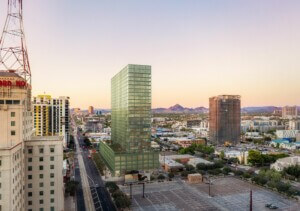Blair Kamin convened a panel of designers at the Chicago Architecture Foundation last Wednesday for a discussion around themes explored in his recent series “Designed in Chicago, Made in China,” in which the Chicago Tribune architecture critic assessed the effects of that country’s rapid development on urbanism and design.
“It’s often said that architecture is the inescapable art,” Kamin said to lead off the talk. “If that’s true then China’s urbanization is the inescapable story.”
Joining Kamin were Jonathan D. Solomon, associate dean at the School of Architecture at Syracuse University; Thomas Hussey of Skidmore, Owings & Merrill; Ralph Johnson of Perkins + Will; and Silas Chiow, SOM’s China director. The event was part of the Tribune‘s “Press Pass” series.
If you haven’t read Kamin’s series, you should. It examined contemporary Chinese cities and some U.S. designers thereof, giving special attention to trends in three categories: work, live, and play. Photographer John J. Kim illustrated with visuals.
“In regards to street life and public space,” said SOM’s Hussey, “there can be a lack of an attitude towards it.” Long Chinese “megablocks” in Shanghai’s soaring Pudong district facilitate an urbanism not on the street, which few Americans would find walkable, but it has given rise to a kind of vertical urbanism within mixed-use towers and urban malls. Hussey pointed to SOM’s plan for a new financial district in the port area of Tianjin, China’s fourth largest city, which seeks to restore the street life present in Chinese cities before rapid modern development.
And while Chinese cities are growing up, they’re also growing out. Ralph Johnson of Perkins + Will reminded the audience that in the absence of property taxes, Chinese municipalities make money for new development by selling off land. That creates a ripple effect of rising property values and a pressure to sell that is devouring arable farmland. That trend’s not likely to slow down, said SOM’s Silas Chiow, since part of China’s national strategy to turn the largely manufacturing nation into a consumer country is to continue its rapid urbanization.
That pressure helped produce China’s enviable mass transit systems and light rail connectivity, but also a homogeneity of design that some have called dehumanizing. Height limits, uniform standards for south-facing units and other design requirements that by themselves improve standard of living can breed sprawling, cookie-cutter developments that are easy to get lost in. Still, housing projects in China don’t carry the social stigma that they do in the U.S., commented a few panel members, in part because they’ve brought modern amenities to so many.
Where China’s urbanization goes from here, however, is an open question. Images of smog-choked skylines remind some of Chicago in 1900, but the situation is not a perfect analogue. For one, the problem of carbon pollution is far more urgent now than it was then, and its sources far more potent.
“Will China be the death of the urban world,” asked Kamin at the panel’s close, “or its savior?”










